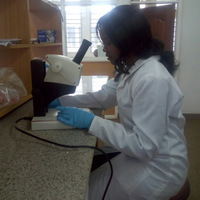Bean (Phaseolus vulgaris) is the most important food legume, however there is an increasing decline in performance and production due to pest attack especially from the aphids. Pest infestation is even higher during the dry season hence... more
Bean (Phaseolus vulgaris) is the most important food legume, however there is an increasing decline in performance and production due to pest attack especially from the aphids. Pest infestation is even higher during the dry season hence causing a serious damage to the crop. Therefore there is an urgent need to come up with methods like integrated pest management in order to control the pest, which destroys the crop by sucking the nutrients, excrete honey dew which attract saprophytic fungi and is also known to transmit a number of viruses to the bean plant. The aim of this study was to: determine efficacy of integrated management on bean aphid infestation and to determine the efficacy of integrated management on bean performance. This was done with an overall aim of increasing the yields of beans. Data collection was done using a 4x2x2 factorial experiment comprising of Bean variety cv. Nyayo ,two rates of seed dressing chemical (with and without) using (Gaucho) Imidacloprid, two ra...
Research Interests:
Bean (Phaseolus vulgaris) is the most important food legume, however there is an increasing decline in performance and production due to pest attack especially from the aphids. Pest infestation is even higher during the dry season hence... more
Bean (Phaseolus vulgaris) is the most important food legume, however there is an increasing decline in performance and production due to pest attack especially from the aphids. Pest infestation is even higher during the dry season hence causing a serious damage to the crop. Therefore there is an urgent need to come up with methods like integrated pest management in order to control the pest, which destroys the crop by sucking the nutrients, excrete honey dew which attract saprophytic fungi and is also known to transmit a number of viruses to the bean plant. The aim of this study was to: determine efficacy of integrated management on bean aphid infestation and to determine the efficacy of integrated management on bean performance. This was done with an overall aim of increasing the yields of beans. Data collection was done using a 4x2x2 factorial experiment comprising of Bean variety cv. Nyayo ,two rates of seed dressing chemical (with and without) using (Gaucho) Imidacloprid, two rates of botanical pesticide (Tephrosia vogelii) extract at 0 and 20w/v %) applied as a foliar spray and four rates of inorganic fertilizer Triple Super Phosphate (TSP)-zero rate (no fertilizer), Low rate (TSP at, 50 kg product/ha), medium rate, 75 kg/ha and high 100 kg product/ha). The four factors were combined in a completely factorial arrangement in randomized complete block design replicated three times constituting 16 treatment combination giving 48 experimental plots which were planted in five row field plots measuring 2m by 2.25 m. The experimental design was Randomized Complete Block Design (RCBD) replicated three times. Each experimental plot measured 2.0 M x 2.0 M with inter row and intra row spacing of 45 cm and 20 cm respectively. Clean bean variety seed sourced from local market was used in this study to reflect local farmer's source of planting material. Data collected on all the parameters was subjected to analysis of variance procedure using general linear model of the statistical analysis system (SAS) package (SAS Institute, 1996). However, data on aphid count and number of plants infested by bean aphids were first subjected to a transformation of square root of x+ 1 in order to reduce heterogeneity of the data before being analalysed. Mean separation was done according to Fisher's protected LSD significant difference Test at 5% level of significance. The Pearson's correlation test was performed on the means of the parameters investigated to compare on their relationships. Results showed that the aphid population builds up and damage in bean crop was significantly reduced when combined application of treatments of seed treatment using Imidacloprid at 700 ml/100kg seed was done on bean seed before planting and planting with 100 kg/ha of tsp fertilizer, then followed with a Biopesticide foliar spray of T. vogelii at 20%w/v from 30 days after emergence (30DAE) thereafter spraying on a weekly basis better than any other treatment applied. The application of T.vogelii at 20%w/v alone on weekly basis significantly reduced bean aphid infestation better than control and application of seed dress alone. Use of seed dressing alone was only temporary measure during seedling stages and should be supported with other control measure one month after crop emergence as it does not provide complete control of bean aphid infestation for the whole season during bean growth. The integration of TSP fertilizer, seed dresser, and application of foliar spray of Tephrosia leaf extract at 20%w/v greatly reduced Aphis fabae infestation and population build in bean crop below damaging levels and resulted in improved bean grain yield, Application of TSP fertilizer rates alone did not seem to have effect on bean aphid infestation on bean crop as population build up was observed under all the rates applied. It's therefore recommended to use integrated control in order to increase performance and production of beans.
